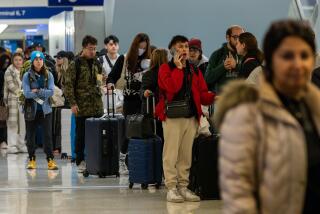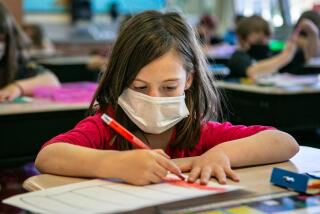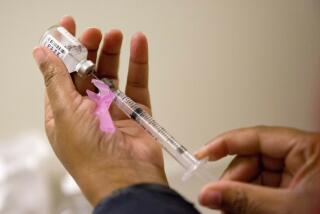New swine flu cases reported, but pace seems to slow
- Share via
As new swine flu cases continued to be reported across the country Thursday -- most of them scattered outbreaks in new states -- school systems in Seattle and Huntsville, Ala., were closed after health officials discovered suspected cases in each.
A late afternoon tally by the U.S. Department of Education found that 298 schools around the country had shut down for a few days, triple the number that had been closed on Wednesday. The closings affected about 172,000 students, leaving parents scrambling to find alternative day care arrangements.
Federal officials suggested such closings, and most researchers agreed with them.
“School closings will probably not themselves stop a pandemic,” said Dr. Frank Esper, a pediatric infectious diseases specialist at Cleveland’s Rainbow Babies & Children’s Hospital. “But they slow down the spread of the virus and give us a little extra time to study it and figure out how to treat it.”
Meanwhile, the Centers for Disease Control and Prevention said in its daily noon posting that it had received reports of 109 confirmed cases of the disease, which health authorities are now calling H1N1 flu rather than swine flu, reflecting the fact that it is transmitted easily in humans and has never been found in pigs.
The new CDC tally includes 10 new cases in South Carolina and one or two in each of eight other states. That total does not include newly reported cases in California, Minnesota, Nebraska, Delaware, New Jersey, Colorado, Georgia and Virginia and an infected Marine at the Twentynine Palms base, bringing the U.S. total to 136 as of Thursday night.
“There are many more states with suspected cases,” said Dr. Richard E. Besser, the CDC’s acting director. At least 40 probable cases have been identified in California, including four in Riverside County, one in Los Angeles County, two in Orange County, 10 in Imperial County and eight in San Diego County.
Dr. Gil Chavez of the California Department of Public Health said eight of the patients had been hospitalized.
The White House said Thursday that one member of the advance team that prepared for President Obama’s visit to Mexico last month is suspected to have suffered from H1N1 flu on his return, but has recovered. His wife and children now have symptoms, however.
There has still been only one death in the U.S., a 22-month-old Mexican national who died in a Houston hospital Monday.
The World Health Organization said the number of confirmed H1N1 cases reported to it had climbed from 148 to 257.
Dr. Keiji Fukuda, assistant director-general for health security and environment at the organization, said that Mexico accounted for most of the increase, resulting mainly from lab workers making their way through the backlog of stored specimens, not from new cases.
To date, he added, only seven of the 176 influenza-related deaths in Mexico have been confirmed to be H1N1. Mexican authorities said the number of deaths confirmed to be linked to H1N1 is 12.
Mexican authorities also said that one of the dead was a Bangladeshi immigrant who had been working as a street vendor for six months. His brother had come to visit him for several days but became ill and returned home. Some viewed this news as evidence of Mexican officials’ attempt to shift blame for the outbreak elsewhere.
On Wednesday evening, WHO Director-General Dr. Margaret Chan had raised the world infectious disease alert level from Phase 4 to Phase 5, reflecting the fact that human-to-human transmission has been observed in at least two countries in one region -- in Mexico and the United States in the organization’s North American region.
But at a Thursday news conference in Geneva, Fukuda said, “There is nothing today which suggests that we should be moving toward Phase 6,” the highest alert level.
Kathleen Sebelius, U.S. secretary of Health and Human Services, said Thursday that her department was purchasing an additional 13 million courses of the antiviral drug Tamiflu -- at a cost of $251 million -- to use if needed. She said the department had sent 11 million courses to states and 400,000 to Mexico.
In addition to the school closings, officials in Texas and Alabama have canceled all high school sporting events for at least a week.
Although several modeling studies by researchers at Georgia Institute of Technology, Imperial College London and the University of Washington have shown that school closings can be effective, some experts questioned how they are being done.
Dr. Michael T. Osterholm of the University of Minnesota said that the closings would calm some fears among parents and children, but would have little benefit if the students congregated on playgrounds and elsewhere during their time off.
He also said that the idea of closing all schools in a district when suspected cases have been found in only a couple was probably not productive. “What’s the benefit to the other schools if only students in a few have had contact” with an H1N1 victim? he asked.
Dr. Christian Sandrock of UC Davis, a deputy health officer in Yolo County who specializes in disaster preparedness, agrees. School closures can work if they are targeted -- if, for example, there is a known case -- he said. “But,” he added, “it is also a dramatic action.”
--
Times staff writers Ken Ellingwood in Mexico City, Eric Bailey in Sacramento and Shari Roan and Kimi Yoshino in Los Angeles contributed to this report.
--
(BEGIN TEXT OF INFOBOX)
The toll
Confirmed swine flu cases as of 8 p.m. PDT Thursday:
United States: 136
New York: 51
Texas: 26
California: 18
South Carolina: 10
New Jersey: 5
Delaware: 4
Arizona: 3
Maine: 3
Colorado: 2
Kansas: 2
Massachusetts: 2
Michigan: 2
Virginia: 2
Georgia: 1
Indiana: 1
Minnesota: 1
Nebraska: 1
Nevada: 1
Ohio: 1
Mexico: 300
Canada: 34
Spain: 13
Britain: 8
New Zealand: 3
Germany: 3
Israel: 2
Austria: 1
Switzerland: 1
Netherlands: 1
--
Sources: U.S. Centers for Disease Control and Prevention, World Health Organization, state agencies, Associated Press and Times research
More to Read
Sign up for Essential California
The most important California stories and recommendations in your inbox every morning.
You may occasionally receive promotional content from the Los Angeles Times.













